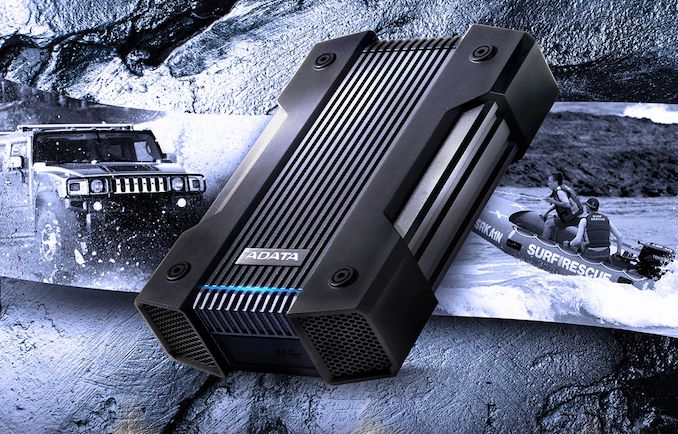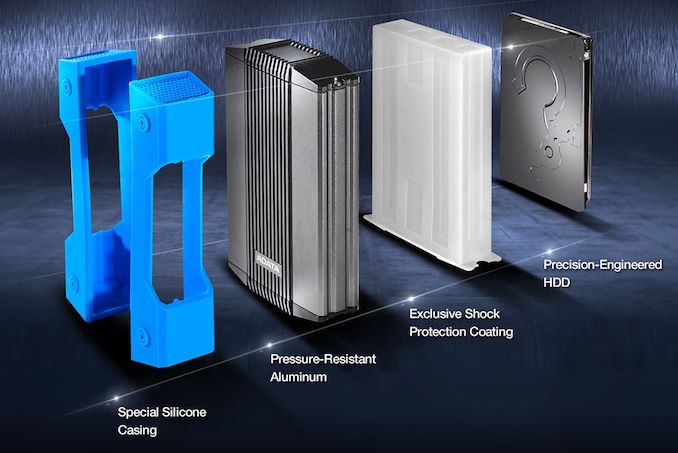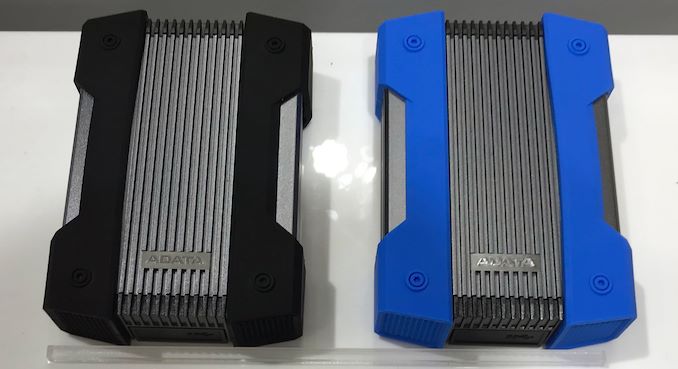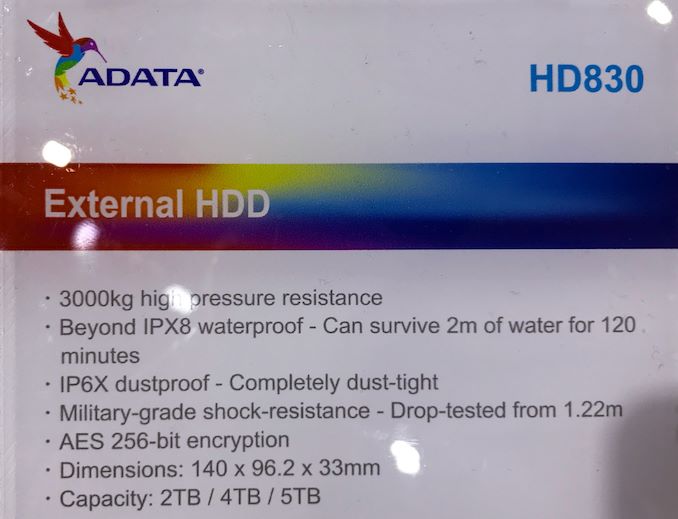ADATA Demonstrates HD830 Ultra-Rugged HDDs
by Anton Shilov on June 21, 2019 1:00 PM EST- Posted in
- Storage
- HDDs
- ADATA
- Ruggedized
- Trade Shows
- External
- Computex 2019

There are many reasons why external storage devices are gaining traction these days, so storage vendors have been aiming to expand their product lineups and offer storage solutions that meet market needs while still offering a degree of differentiation from their rivals. ADATA for its part already has a comprehensive lineup of consumer-grade external HDDs and SSDs, so at this year’s Computex the company introduced its new HD830 ruggedized external hard drive, which is designed to withstand rather tremendous pressure and is water, dust, and shock-proof.
ADATA’s HD830 comes in 2 TB, 4 TB, and 5 TB capacities. The drive can survive up to 3 tons (3000 kilograms) of pressure – enough to survive being run over by a car. It can also withstand drops from 4 feet as well as the regular bumps of life. The HD830 storage devices are completely sealed against dust and water: they can survive for 120 minutes when submerged at a two-meter depth. The drives use a micro-B USB 3.1 to USB 3.1 Type-A cable to connect to their hosts.
To ensure the durability of their drives, for the HD830 series ADATA packs a 2.5-inch HDD into a special plastic container that guards against shocks and liquids, which is then put inside an aluminum enclosure that further reinforces the whole container. The aluminum chassis is then itself protected by using a special silicone shock-absorbing casing. Last but not least, the HD830 has its own shock sensors as well as LEDs that detect and inform users the drive is hit during its operation or a disk error occur.
One thing to keep in mind is that modern high-capacity 2.5-inch HDDs are based on shingled magnetic recording with all of its peculiarities when it comes to performance. So expect HD830 to come with those associated performance quirks. Though admittedly, the main advantage of these drives is their rugged construction, not extreme performance.
ADATA is already selling its HD830 external HDDs via Amazon for $103, $152, and $196 for 2 TB, 4 TB, and 5 TB, respectively. Expect wider retail availability in the near future.
| Want to keep up to date with all of our Computex 2019 Coverage? | ||||||
 Laptops |
 Hardware |
 Chips |
||||
| Follow AnandTech's breaking news here! | ||||||













12 Comments
View All Comments
mckirkus - Friday, June 21, 2019 - link
I thought it would be cheaper to do this with an SSD in m.2 form factor for the 2TB model but these HDDs are only $99 on Amazon. A much smaller rugged SSD version of this would be a lot tougher, but for the larger options at this price it seems like a reasonable option.qlum - Friday, June 21, 2019 - link
Still if you really cared about it being. Touch a hdd just doesn't make much sense. Being more temperature, movement and dust sensitive by nature while also being a lot heavier.cerberusss - Saturday, June 22, 2019 - link
Micro-B USB port on the drive? Isn't that a bit of a weird choice in this day and age? I'd expect USB-C.PVG - Saturday, June 22, 2019 - link
Why?wumpus - Saturday, June 22, 2019 - link
It's spinning rust. It can't saturate a USB-B port. And you probably want to connect it to all sorts of obsolete hardware as well (rugged stuff tends not to be upgraded as often).CharonPDX - Sunday, June 23, 2019 - link
The physical port has nothing to do with the speed. USB 3.1 Gen 2 10 Gbps is available over Micro-B. Just as there are USB-C devices that are only USB 2.0 480 Mbps.Moving to USB-C is just future-proofing to the day that USB-C is everywhere.
Lord of the Bored - Wednesday, June 26, 2019 - link
In fairness, the micro-B connector that supports USB3 speeds is much wider than the "normal" micro-B connector(much like how full-size USB-B is taller if it supports USB3). USB-A is the anomaly in that the connector didn't get larger when USB3 support was added.And when we're worried about ruggedness, a smaller connector is less vulnerable. This is one of the places where I think the USB-C fan club has a point.
Also, I've seen exactly one micro-USB3 cable in my life. So if the cable gets damaged and you need to replace it(a likely situation if the drive's rugged nature is tested while it is plugged in), USB-C is a more convenient option.
wumpus - Saturday, June 22, 2019 - link
Weird device. Looks like a consumer "kid safe" drive rather than any "rugged drive" I've ever seen. Most such devices would cost 10 times what this does (and presumably go straight to SSD: no reason to have a failure point like a spinning disk).I'd also suspect that for real rugged markets, the 2TB drive would be the most popular thanks to 2TB limits in older systems. Upgrading rugged gear is *expensive*.
Finally, "military rugged" is a meaningless phrase (and a drop test doesn't count. UPS has a drop test, I've never heard of one for MIL-STD). You want to know which MIL-STD specs the thing passed, especially MIL-STD 801 (and other MIL-STD tests, I'm not a mechanical engineer so I'm not that familiar with the shock&vibe specs).
samerakhras - Saturday, June 22, 2019 - link
Portable HDD are Dying. with 2TB SSD now costs around $150 there is no point at all any one buys external HDDevernessince - Sunday, June 23, 2019 - link
You can get 8TB external HDDs for $100. They are nowhere near dead.